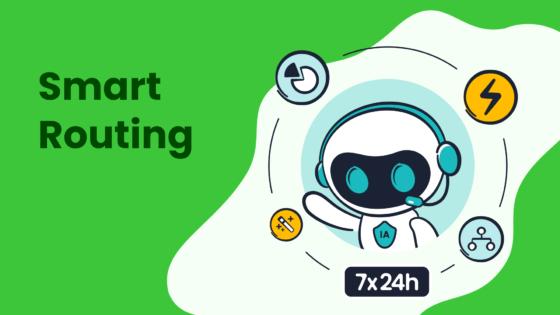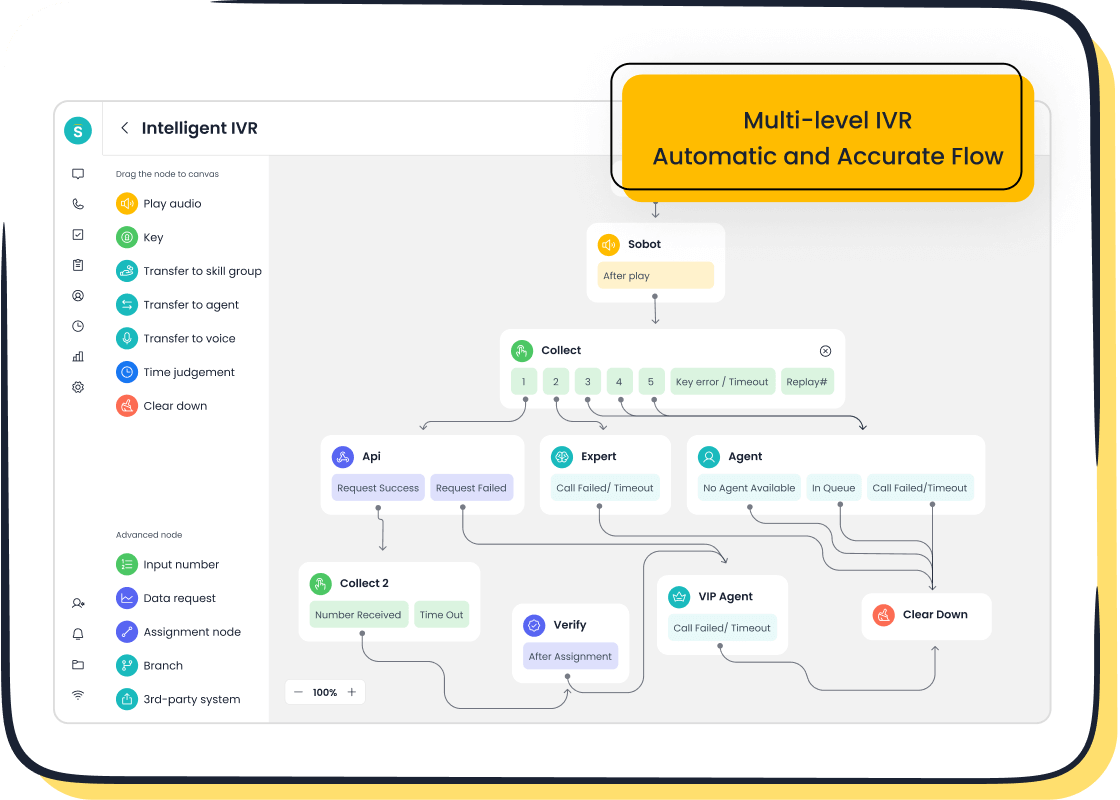What is Inbound Call Center and Outbound Call Center Main Functions

Inbound call centers receive calls from customers seeking support, while outbound call centers proactively make calls to reach leads or gather feedback. Understanding what is inbound call center and outbound call center is essential for businesses to select the right approach for their customer engagement strategies. Inbound call center agents primarily focus on customer service and issue resolution, whereas outbound call center agents drive sales and collect valuable information.
Sobot call center solutions, powered by Sobot AI, offer advanced capabilities to optimize both inbound and outbound operations, enhancing efficiency and customer satisfaction. The table below highlights global adoption trends for these call center types:
| Metric/Aspect | Inbound Call Centers | Outbound Call Centers |
|---|---|---|
| Share of Global Call Volume | Over 65% | Over 35% |
| Agent Employment (2023) | Part of 18M agents | Over 12M agents |
| Avg. Resolution Rate (2023) | 81% | 7.2% sales success rate |
With Sobot’s comprehensive call center platform, businesses can leverage intelligent tools to meet their unique inbound and outbound communication needs effectively.
What is Inbound Call Center and Outbound Call Center

Inbound Call Center Overview
An inbound call center is a specialized facility where agents handle incoming calls from customers. These calls often relate to support, information requests, or help with products and services. The main goal of an inbound call center is to provide excellent customer service and resolve issues quickly. Agents answer questions, solve problems, and guide customers through processes. Many businesses use inbound call centers to improve customer satisfaction and build loyalty.
- Inbound call centers focus on:
- Answering customer questions and concerns.
- Providing technical support and troubleshooting.
- Processing orders and payments.
- Handling complaints and offering solutions.
- Giving information about products, services, and company policies.
Companies in retail, healthcare, technology, and e-commerce often rely on inbound call centers. These centers help manage high volumes of calls, especially during busy seasons or special events. By using advanced tools like Automatic Call Distribution (ACD) and integrated customer data systems, agents can deliver fast and personalized service. Sobot, a leader in call center service solutions, designs its platforms to support these needs. Sobot’s technology ensures agents have the right information at their fingertips, which helps them resolve issues on the first call and keep customers happy.
Inbound call centers measure success by customer satisfaction, first call resolution, and average handle time. These metrics show how well the center meets customer needs. Businesses choose inbound call centers to reduce missed calls, improve communication, and free up staff for other important tasks. This approach helps companies maintain strong relationships with their customers.
Outbound Call Center Overview
An outbound call center is a facility where agents make outgoing calls to customers or prospects. The main purpose is to reach out proactively for sales, lead generation, surveys, or reminders. Outbound call centers play a key role in helping businesses grow and connect with more people.
- Outbound call centers focus on:
- Making sales calls and promoting products or services.
- Generating leads and setting appointments.
- Conducting customer surveys and collecting feedback.
- Following up on previous interactions or unpaid bills.
- Sending reminders for appointments or important events.
Industries such as collections, healthcare, and financial services depend on outbound call centers. These centers help companies contact large numbers of customers efficiently. For example, healthcare providers use outbound call centers to remind patients about appointments. Collections agencies use them to arrange payments for overdue bills. Outbound call centers also use automated dialing systems and customer profiles to make calls more effective and targeted.
Sobot’s call center service platform supports outbound operations with features like bulk outbound tasks, smart call routing, and real-time analytics. These tools help agents reach more customers, track results, and improve conversion rates. Outbound call centers measure success by sales conversion rates, number of calls made, and customer engagement. This proactive approach helps businesses increase revenue and strengthen customer relationships.
Tip: Understanding what is inbound call center and outbound call center helps businesses choose the right call center service for their goals. Sobot’s expertise in both areas ensures companies can deliver excellent customer experiences, whether they need to handle incoming support calls or reach out to new customers.
Inbound Call Center Functions
Main Roles
Inbound call centers play a vital role in managing customer service requests and ensuring customer satisfaction. Agents handle a wide range of customer inquiries, from product questions to technical support. Their responsibilities include:
- Providing customer support for product and service inquiries.
- Resolving complaints and troubleshooting issues.
- Processing orders, payments, and returns.
- Addressing billing questions and managing refunds.
- Scheduling appointments and sending reminders.
- Offering help desk support for general questions.
- Routing incoming calls to the right agents.
- Recording calls for quality monitoring.
- Collecting data for reporting and analytics.
- Supporting customers in multiple languages.
- Delivering emergency support around the clock.
- Managing live chat, email, and social media inquiries.
- Accessing customer history through CRM integration.
- Enabling self-service options with FAQs and chatbots.
Agents in inbound call centers must respond quickly and professionally. They document every customer interaction in the system and escalate complex issues when needed. Skills such as empathy, communication, and problem-solving are essential. These roles help build trust and improve customer satisfaction. Studies show that 77% of customers expect to speak with a human when they contact a business, highlighting the importance of live support in customer experience.
Sobot Voice/Call Center Features

Sobot enhances inbound call center services with advanced features designed for efficiency and satisfaction. The intelligent IVR system allows businesses to customize greetings and route calls to the best agent or team. The unified workspace gives agents access to all customer information, making it easier to resolve customer inquiries on the first call.
Key features include:
- Real-time monitoring and analytics for tracking performance.
- Caller ID for instant customer identification.
- Automatic Call Distribution (ACD) to connect customers with the right agent.
- Call transfer and supervisor barge-in for flexible support.
- Time-based routing to match customer time zones.
- Mobile app support for agents on the go.
- Call recording for compliance and training.
- AI-powered Voicebot for handling routine inquiries and escalating complex issues.
- Seamless CRM integration for personalized service.
Sobot’s platform delivers a 99.99% uptime, ensuring reliable inbound call center services. Businesses using Sobot report up to a 54% improvement in first-contact resolution and a 41% reduction in average handle time. These features help companies boost customer satisfaction and streamline every customer interaction.
Outbound Call Center Functions

Main Roles
Outbound call centers play a crucial part in driving business growth. Agents in these centers make outgoing calls to customers and prospects for various purposes. Their daily tasks include:
- Conducting sales calls to promote products and services.
- Engaging in lead generation by reaching out to new prospects.
- Following up with customers after previous interactions.
- Gathering feedback through customer surveys and market research.
- Setting appointments and sending reminders to reduce no-shows.
- Managing billing reminders and payment follow-ups.
- Supporting fundraising and awareness campaigns.
- Re-engaging former customers with targeted offers.
Agents use multiple tools and databases to document every interaction. They maintain up-to-date knowledge of company products and policies. They also analyze customer responses to improve future outreach. Outbound call center services help businesses personalize customer interactions, which increases satisfaction and conversion rates. These centers also collect valuable insights that inform sales and marketing strategies. By focusing on sales and lead generation, outbound call centers create new revenue streams and expand market reach.
Outbound call centers transform customer engagement from reactive to proactive, turning every call into an opportunity for sales and relationship building.
Sobot Outbound Solutions
Sobot offers advanced outbound call center service solutions designed to maximize productivity and efficiency. The platform features bulk outbound tasks, which automate outgoing calls and assign leads to agents based on set priorities. This automation eliminates manual dialing, allowing agents to focus on meaningful conversations with customers.
Sobot’s AI-powered voicebots use technologies like Automatic Speech Recognition and Natural Language Processing. These voicebots handle routine outbound marketing and sales calls, process data, and escalate complex issues to human agents when needed. The system supports batch automated campaigns, which can improve sales by over 30%. Integration with popular CRM platforms such as Salesforce and Shopify streamlines workflows and enhances lead management.
Sobot’s outbound call center solutions enable businesses to scale their sales and marketing efforts. The platform provides real-time call tracking and analytics, helping teams monitor performance and refine strategies. By leveraging AI and automation, Sobot empowers agents to deliver personalized outreach, increase customer loyalty, and drive revenue growth.
Key Differences Between Inbound and Outbound Call Centers
Purpose and Approach
Inbound call centers focus on receiving calls from customers who need help, information, or support. Their main goal is to provide excellent customer service and resolve customer inquiries quickly. Agents in these centers use patience and empathy to improve satisfaction and build trust. In contrast, outbound call centers take a proactive approach. Agents reach out to customers or prospects to promote products, conduct marketing campaigns, or drive lead generation. Outbound teams use structured calling strategies and persuasive communication to achieve sales targets. The difference in approach shapes the overall customer experience and impacts customer retention.
Inbound centers build loyalty by solving problems, while outbound centers create new opportunities through active outreach.
| Aspect | Inbound Call Centers | Outbound Call Centers |
|---|---|---|
| Purpose | Customer support, satisfaction, retention | Sales, marketing, lead generation, market research |
| Approach | Reactive, service-oriented | Proactive, goal-driven |
| Customer Role | Initiates contact | Receives contact |
| Success Metric | Customer satisfaction, first-contact resolution | Conversion rate, sales outcomes |
Technology and Skills
Inbound call centers rely on technologies like Automatic Call Distribution (ACD) and Interactive Voice Response (IVR) to manage incoming customer inquiries efficiently. These tools help route calls and allow customers to solve simple issues on their own. Outbound centers use AI-powered predictive dialing and CRM systems to manage contacts and personalize calls. Both types benefit from VoIP systems and omnichannel platforms, which improve call center performance and agent efficiency.
Agents in inbound centers need strong listening skills, empathy, and technical knowledge to resolve customer inquiries and increase satisfaction. Outbound agents require confidence, persuasive communication, and resilience to rejection. They must stay focused on sales and marketing goals. Sobot’s unified platform supports both skill sets, offering workflow automation, AI voicebots, and real-time analytics for hybrid call center strategy.
Business Impact
Inbound call centers drive customer satisfaction, retention, and loyalty by resolving issues and collecting feedback. Key metrics include Customer Satisfaction Score and Net Promoter Score. Outbound centers focus on lead generation, sales growth, and market expansion. They measure success through conversion rates and cost per acquisition. Combining both models in a hybrid solution can improve customer retention and satisfaction, while also increasing revenue. Sobot enables businesses to manage both inbound and outbound functions seamlessly, supporting a complete customer experience across all channels.
Choosing the Right Call Center for Your Business
Assessing Business Needs
Selecting the right call center solution starts with understanding business goals and customer expectations. Companies should define clear criteria that match their operational needs. For example, a business focused on customer satisfaction may choose an inbound call center to handle support and feedback. A sales-driven company might prefer outbound services to reach new customers and boost retention.
Businesses must consider several factors:
- The main purpose of the call center, such as support, sales, or a mix of both.
- The nature of customer interactions, whether reactive or proactive.
- The skill set required for agents, including empathy and communication for satisfaction.
- Operational efficiency, including response times and workflow management.
- Scalability and flexibility to handle seasonal changes in customer demand.
- Technical support availability and ease of software integration.
- Cost structure, including all fees and transparent billing.
- The choice between cloud-based or on-premise systems, based on company size and data control needs.
A table can help compare options:
| Factor / Call Center Type | Inbound Call Center | Outbound Call Center | Hybrid Call Center |
|---|---|---|---|
| Primary Goal | Support, feedback | Sales, outreach | Both |
| Interaction Nature | Reactive | Proactive | Mixed |
| Agent Skills | Support, empathy | Sales, telemarketing | Broad |
| Efficiency Focus | Response quality | Outreach conversion | Streamlined |
| Scalability | 24/7 availability | Campaign scaling | Seasonal demand |
| Customer Experience | Personalized | Proactive retention | Seamless |
Companies should also assess challenges like high contact volumes, agent turnover, and language barriers. Customizing evaluation forms and using real-time monitoring can improve agent performance and customer satisfaction.
Tip: Businesses that align call center type with their goals and customer needs see higher satisfaction and better retention.
Sobot Customer Success Story
Weee!, America’s largest online Asian supermarket, faced challenges with inflexible systems and language barriers. The company needed a solution that could handle high volumes of customer inquiries and improve satisfaction. Sobot provided a flexible IVR system, multilingual support, and an integrated workspace. These features helped Weee! increase agent efficiency by 20% and reduce resolution time by 50%. The customer satisfaction score reached 96%, showing the impact of choosing the right call center solution. Sobot’s platform enabled Weee! to deliver fast, personalized service and support a diverse customer base, leading to stronger retention and loyalty.
Inbound call centers handle incoming calls for support and technical help, while outbound centers focus on making calls for sales and lead generation. Hybrid centers combine both, creating a seamless experience. Choosing the right type depends on company goals and resources. Sobot offers cloud-based solutions, analytics tools, and AI-driven automation to help businesses improve customer satisfaction and efficiency. Companies can explore advisory services, workforce management tools, and detailed guides to make informed decisions.
- Main points:
- Inbound centers support existing customers.
- Outbound centers drive sales and gather feedback.
- Hybrid centers offer flexibility and centralized communication.
- Businesses should match call center type to their needs.
FAQ
What is the main difference between inbound and outbound call center services?
Inbound call center services handle incoming calls from customers who need support or information. Outbound call center services focus on outgoing calls for sales, lead generation, or surveys. Each type uses different strategies to improve customer experience and business results.
How does Sobot improve call center performance?
Sobot provides intelligent IVR, unified workspaces, and AI-powered voicebots. These features help agents manage customer inquiries efficiently, reduce response times, and increase customer satisfaction. Real-time analytics allow teams to monitor and optimize call center performance.
Why is customer retention important in call center strategy?
Customer retention helps businesses build long-term relationships and increase loyalty. A strong call center strategy focuses on solving customer service requests quickly and improving satisfaction. Retaining customers costs less than acquiring new ones and boosts overall sales.
What role does lead generation play in outbound call centers?
Lead generation drives business growth by identifying and contacting potential customers. Outbound call centers use sales calls and marketing campaigns to reach new prospects. This process increases sales and helps companies expand their market reach.
Can inbound call center services and outbound call center services work together?
Hybrid call centers combine inbound and outbound functions. This approach allows businesses to handle customer support and sales in one system. Companies benefit from improved customer interaction, streamlined workflows, and higher satisfaction rates.
